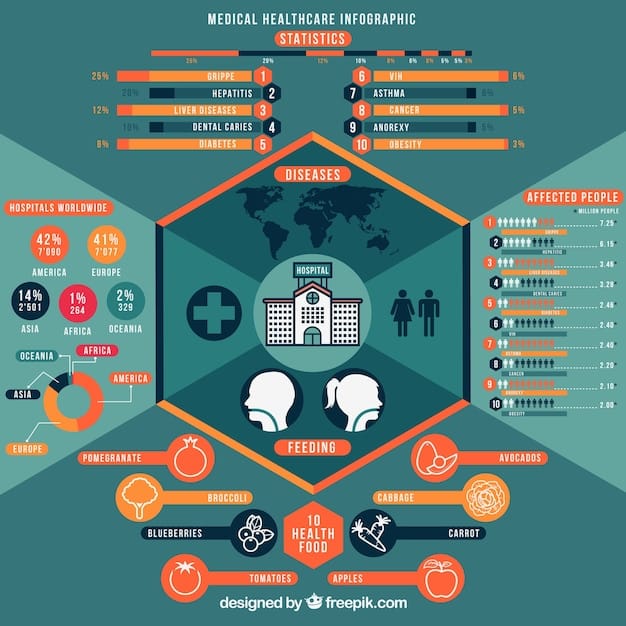Employer Benefits 2025: Choosing the Right Healthcare Options

Employer Benefits Update: New Healthcare Options for 2025 and How to Choose involves understanding the evolving landscape of employer-sponsored healthcare plans, comparing different coverage levels and costs, and making informed decisions that best suit individual and family needs for the upcoming year.
Navigating the world of employer benefits can feel overwhelming, especially when it comes to healthcare. With the Employer Benefits Update: New Healthcare Options for 2025 and How to Choose, employees are faced with various plans and choices. Understanding these options and making the right selections is crucial for both health and financial well-being.
Understanding the Changing Landscape of Employer Benefits
The world of employer benefits is constantly evolving. Staying informed about these changes is crucial for making the best decisions for you and your family. The annual enrollment period is your opportunity to review your options and make adjustments.
Several factors contribute to the changing landscape, including healthcare costs, regulatory updates, and employer strategies to attract and retain talent.
Key Trends in Employer Benefits
Staying abreast of the latest trends can help you anticipate changes and prepare for future enrollment periods. Here are a few key areas to watch:
- Increased Focus on Mental Health: Many employers are expanding their mental health benefits to include telehealth options, employee assistance programs (EAPs), and mental health apps.
- Greater Emphasis on Preventive Care: Employers are incentivizing employees to participate in wellness programs, screenings, and vaccinations to promote overall health and reduce long-term healthcare costs.
- Expansion of Telehealth Services: Telehealth is becoming increasingly popular, offering convenient access to healthcare providers for routine check-ups, consultations, and even some specialist care.
- Personalized Benefits Packages: Some companies are offering more flexible benefits packages that allow employees to customize their benefits to better meet their individual needs.
Understanding these trends will empower you to navigate your employer’s benefits offerings more effectively. Regularly review your options and consider how these changes may impact your choices.
Exploring Different Types of Healthcare Plans
One of the first steps in choosing the right healthcare option is understanding the different types of plans available. Each type has its own set of rules, costs, and coverage levels, so it’s important to compare them carefully.
Common plan types include Health Maintenance Organizations (HMOs), Preferred Provider Organizations (PPOs), and High-Deductible Health Plans (HDHPs).

HMO (Health Maintenance Organization)
HMOs typically offer lower premiums and out-of-pocket costs, but they also have stricter rules. You usually need to choose a primary care physician (PCP) who will coordinate your care and provide referrals to specialists.
PPO (Preferred Provider Organization)
PPOs offer more flexibility than HMOs, allowing you to see specialists without a referral. However, they usually have higher premiums and out-of-pocket costs.
HDHP (High-Deductible Health Plan)
HDHPs have lower premiums but higher deductibles. They are often paired with a Health Savings Account (HSA), which allows you to save pre-tax dollars for healthcare expenses.
Choosing the right type of healthcare plan depends on your individual needs and preferences. Consider factors such as cost, flexibility, and coverage when making your decision.
Evaluating Coverage Levels and Costs
Once you understand the different types of healthcare plans, you need to evaluate the coverage levels and costs associated with each option. This involves comparing premiums, deductibles, co-pays, and coinsurance.
Premiums are the monthly payments you make to maintain coverage. Deductibles are the amount you need to pay out-of-pocket before your insurance starts covering your healthcare expenses.
Understanding Premiums, Deductibles, and Co-pays
Consider how often you typically need medical care when comparing coverage levels and costs. A plan with a lower premium might seem appealing, but it could end up costing you more if you require frequent medical attention.
- Premiums: The monthly cost of your health insurance. Lower premiums often mean higher out-of-pocket costs when you need care.
- Deductibles: The amount you pay out-of-pocket before your insurance starts to pay. Higher deductibles usually mean lower premiums.
- Co-pays: A fixed amount you pay for specific services, like doctor visits or prescriptions.
- Coinsurance: The percentage of healthcare costs you pay after you’ve met your deductible.
Carefully review the plan summaries and compare the costs associated with each option. Don’t forget to factor in potential healthcare expenses for the entire year.
Considering Your Individual Healthcare Needs
Your individual healthcare needs should be a primary factor in your decision-making process. Consider your current health status, any chronic conditions you may have, and your family’s medical history.
If you have a chronic condition, such as diabetes or heart disease, you’ll want to choose a plan that offers comprehensive coverage for your specific needs.
Questions to Ask Yourself
Answering these questions can help you assess your healthcare needs and make informed decisions about your benefits package.
- How often do I typically visit the doctor?
- Do I have any chronic conditions that require regular medical attention?
- Do I take any prescription medications?
- Am I planning any major medical procedures in the coming year?
The answers to these questions will help you prioritize the features and benefits that are most important to you.
Leveraging Available Resources and Tools
Employers often provide resources and tools to help employees make informed decisions about their benefits. Take advantage of these resources to learn more about your options and get personalized recommendations.
Common resources include benefits guides, online decision support tools, and one-on-one consultations with benefits experts.

Benefits Guides and Online Tools
These resources can provide valuable information and guidance as you navigate the enrollment process.
Many employers also offer online tools that allow you to compare different plans, estimate your out-of-pocket costs, and even get personalized recommendations based on your individual needs.
- Benefits Guides: Comprehensive documents that outline your benefits options, coverage levels, and costs.
- Online Decision Support Tools: Interactive platforms that help you compare plans and estimate your healthcare expenses.
- Benefits Fairs: Events where you can meet with benefits providers and learn more about your options.
Utilizing all available resources and tools will empower you to make informed decisions and choose the best healthcare plan for your needs.
Making an Informed Decision for 2025
Choosing the right healthcare plan is a significant decision that can impact your health and financial well-being. Take your time, do your research, and seek guidance from available resources.
By understanding the changing landscape of employer benefits, exploring different plan types, evaluating coverage levels and costs, and considering your individual healthcare needs, you can make an informed decision for 2025.
Key Steps to Take
Following these steps can help you navigate the enrollment process and select the best healthcare plan for your specific needs.
- Review your employer’s benefits guide carefully.
- Compare different types of healthcare plans.
- Evaluate coverage levels and costs.
- Consider your individual healthcare needs.
- Leverage available resources and tools.
Remember, the annual enrollment period is your opportunity to make changes to your benefits package. Don’t miss the deadline to enroll or make any necessary adjustments.
| Key Point | Brief Description |
|---|---|
| 🔍 Understand Plan Types | HMOs, PPOs, HDHPs offer different levels of cost and flexibility. |
| 💰 Evaluate Costs | Compare premiums, deductibles, co-pays, and coinsurance. |
| 🏥 Assess Your Needs | Consider your health status, chronic conditions, and family history. |
| 📚 Use Resources | Leverage guides, online tools, and expert consultations. |
Frequently Asked Questions
▼
HMOs typically require you to choose a primary care physician and get referrals to see specialists, while PPOs offer more flexibility to see specialists without referrals but usually have higher costs.
▼
An HSA is a tax-advantaged savings account that can be used to pay for qualified medical expenses. It’s often paired with a High-Deductible Health Plan (HDHP), allowing you to save pre-tax dollars.
▼
Review your healthcare expenses from previous years, consider any upcoming medical procedures or treatments, and use online tools or calculators provided by your employer or insurance company.
▼
Consider your individual healthcare needs, budget, preferred level of flexibility, and risk tolerance. Compare premiums, deductibles, co-pays, and coinsurance for each plan option.
▼
Check your employer’s benefits guide, website, or intranet portal. You can also contact your HR department or benefits administrator for assistance.
Conclusion
As you prepare for the Employer Benefits Update: New Healthcare Options for 2025 and How to Choose, remember to take a strategic approach. By carefully evaluating your options, understanding the implications of each choice, and utilizing available resources, you can select the benefits package that best suits your needs and ensures both your health and financial well-being in the coming year.





